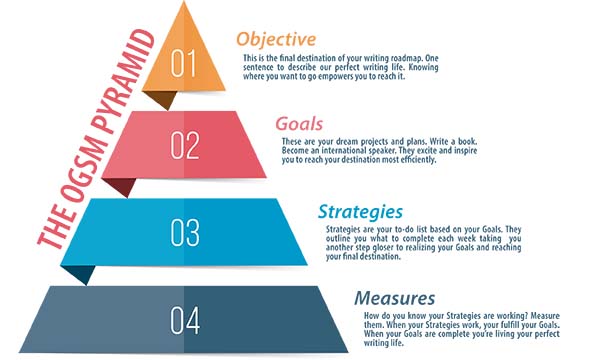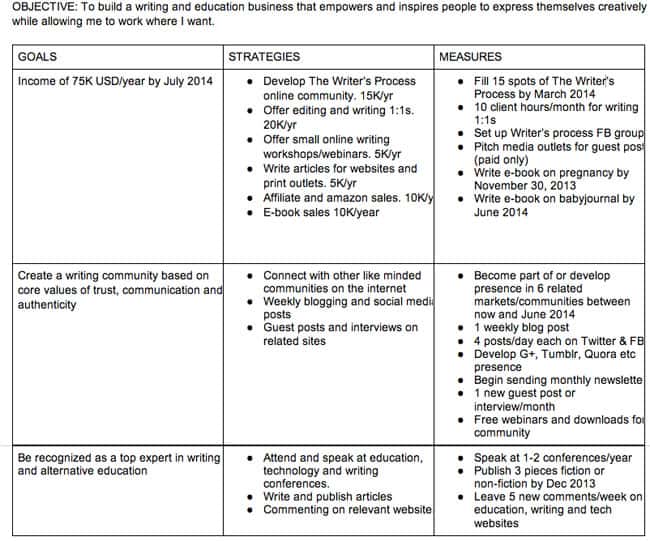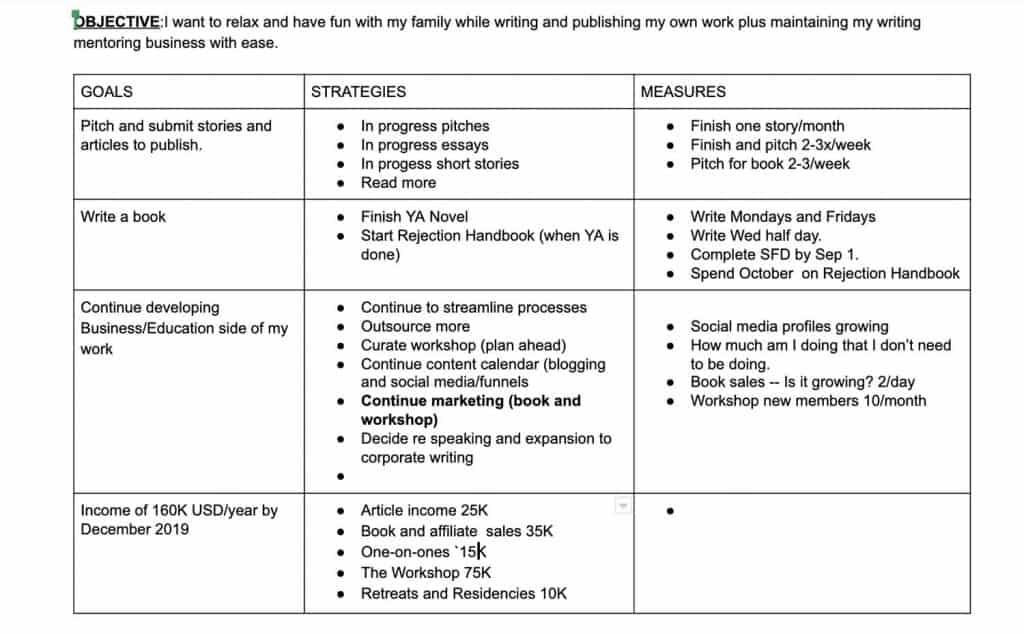You can’t get where you going if you don’t have a destination. Goals are the destination of your writing life. If you don’t have any, chances are, you’re getting lost in your writing. If you don’t know why you’re writing, your writing will be shapeless and misdirected.
If you don’t know what you want, you can’t make it happen.
When I began writing, I used the spaghetti method. Throw it all against the wall and see what sticks. So I’d write an article about domestic violence then one about yoga and maybe then take an editing job in the sciences. Sure, all these individual things interested me, but they didn’t fit into a bigger picture. That meant I wasn’t making the kind of progress I wanted to make.
When you have clear goals, you have a blueprint that guides you in deciding what to write, where to submit, and what to pitch. You begin to establish yourself in a niche.
Won’t choosing a niche paint me into a corner?
No. It won’t.
When you begin with a set of core writing topics, you help editors and clients understand who you are and what you do. It helps you create an audience and a market for your work. Plus, you develop your expertise and trust. Your niche is the starting point. You grow from there. The key when focusing on a niche is to choose your topics strategically.
For example, my main writing goal is to write books about writing, fiction and articles and short stories. I also run an online writing mentorship community called The Workshop. I focus on writing how-tos, running a writing business plus parenting, travel and living as an expat. It’s a very broad set of potential things to write about, so as I make choices about what to write, I fit those choices into an overall plan for my writing life.
In order to keep me on track, I build a simple business plan I call my Writer’s Roadmap aka an OGSM.
What exactly is a Writer’s Roadmap?
A Writer’s Roadmap is a business plan you create for your writing life based on a small business tool called an OGSM. OGSM stands for Objectives, Goals, Strategies and Measures. This tool was first used the 1950s for car manufacturers, but it adapts beautifully for writers and other artists who want to create clear goals and then break down that plan into manageable steps.
The OGSM is the basis for my book The Writer’s Roadmap: Paving the Way To Your Ideal Writing Life. I take you step-by-step through each letter of the process along with writing exercises to help you carve out a clear plan for your writing.

This excerpt from The Writer’s Roadmap describes each part of the OGSM and how it helps you develop an overall plan.
If an OGSM were a road trip, the Objective would be your final destination. The Objective outlines what you want from your writing and how it fits into the bigger picture of your career and life.
We’ll spend more time on your Objective than any other part of the plan because to achieve your dreams, you have to know what they are. The simple act of knowing what you want empowers you. Your Objective, when properly constructed, will guide you for years to come. You won’t need to go back and change it often.Then each successive step — Goals, Strategies, and Measures — breaks your Objective into manageable and actionable parts.
Your Goals are your dream ideas and projects. Goals give you a general idea of what you’d like to do while on your road trip. It’s what you imagine your road trip will be before you start planning any of the details. There’s wind in your face as you drive down the road. You stop to take photos of a gorgeous view or eat foods that are the specialty of that locale. It’s exciting but still fuzzy on specifics.
Most of us get stuck on Goals when we think of our ideal writing life. We know we want to write books or publish in our favorite magazines, but we don’t yet know how to accomplish these things.Strategies start to fill in the how-to of your Goals. On your road trip, they are the specific towns you’ll visit, the things you’ll eat, and the attractions that make you pull over to the side of the road. In your writing life, Strategies are the to-do building blocks, the actionable steps that allow you to make your Goals a reality.
Finally, Measures are the ways you quantify each Strategy to evaluate whether or not it’s working for you. This is how many pitches you send, how many pages you write, and how much money you make when publishing. Once we’ve created the rest of your OGSM plan, we’ll talk about how Measures allow you to determine whether or not your Strategies are working.
To realize your writing plan, you begin with the M and work backwards. When you’ve achieved your Measures, you’ve completed your Strategies. When your Strategies are in place, you’ve met your Goals. And when you’ve fulfilled your Goals, you are living Your Life’s Objective.
Your writing goals will evolve over time.
My first Objective was very similar to my current objective. They both include writing and mentoring others. I include what I’d like to achieve as well as the amount of money I’d like to make and deadlines. These are the benchmarks for measuring whether or not my plan is working.
My first OGSM was based on speculation. I wasn’t yet sure of what I wanted to write or how I wanted to structure my writing group. I also had no idea how much money my writing and services were worth. The numbers and dates were pure guesswork, too, as I had no idea how long it would take to implement each step.
The key is to design an image of the kind of writing life you want to create and lay out the steps you plan to take to get there. As you do the work of actualizing each step, you quickly learn what you want to keep and what needs to change.
Below you’ll see my very first Writing Roadmap:

Between that first OGSM and now, I completed the Goal I made for my writing life. I built my writing group. I wrote and published my book. I published articles and became a recognized expert in my topic. My new OGSM includes many of the elements from my original OGSM, but I’ve refined my method as I learned more about what I want to do.
My 2019 Writing Roadmap:

Over the years, I learned that as much as I love working with people one-on-one, the number of clients I can manage over the course of the year is limited. I also prefer the dynamic of The Workshop, because it allows for a higher level of community and collaboration.
Mainly, I realized I wanted more time to write, and by focusing on my mentor role in the Workshop, I can offer more opportunities to more people while still having enough time to develop my own writing.
What happens when plans change?
If you’re anything like me, you tend to be distracted by shiny new things. You find a new creative endeavor and want to run with it. An OGSM reminds you that if something doesn’t serve your current goals, it goes on the back burner.
I’d like to start speaking at conferences more. I’d also like to create my own writing conference. But for now, neither option takes first priority in my plan, so for now, they’re on my “later” list.
Of course, you don’t have to say no to every new thing that comes your way. It simply means you need to think twice before taking it on, You want to make sure whatever you choose fits into your overall plans.
Give your writing goals the personal touch
It’s easy to dive into work to the exclusion of all else. That’s why it’s important to incorporate your core values in your writing plan. Your core values create boundaries around your work life by including them in your Objective.
Take a look at my 2019 Writing Roadmap Objective: I want to relax and have fun with my family while writing and publishing my own work plus maintaining my writing mentoring business with ease.
Each of the bolded words refers to a topic important to me. They are the core values that guide my writing goals. They sit at the center of my niche and expertise, sending a clear message to my audience. My core values offer me a broad base of ideas for my writing while paving a clear roadmap for my writing life.
Now, it’s your turn. I can’t wait to see what you create.
